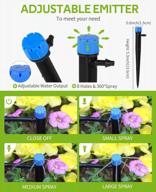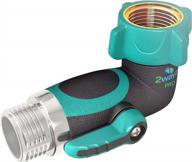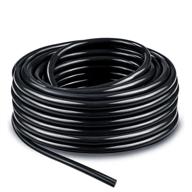
Review on Efficient Self-Watering For Your Garden With WayinTop'S Automatic Irrigation DIY Kit by Damion Pasquale

Zero documentation but good components
I read other reviews that mentioned that you had to contact the seller to get the data package that goes with this kit, which is a bit stingy if you ask me, hence the two stars for ease of use.I recognize that this is a DIY kit, but even so, you have to be able to identify the components and be able to determine their functional parameters.Since I can't post links to external websites in this review, I'm going to tell you to do the following:1. For the soil capacitance sensor, do a Web search for DFROBOT Capacitive Soil Moisture sensor. DFROBOT's wiki tells you how to calibrate the sensor so you can make sense of the voltage values from the Analog Out pin. You'll be testing dry soil and water as your 0% and 100% conditions respectively. You'll want your expected measurement range to fall somewhere in the middle of the range of the sensor to get accurate results.2. Again for the soil sensor, other users have suggested you seal up the edges of the sensor blade to prevent corrosion and get more life out of it.3. For the relay modules, they're JQC-3FF-S-Z packages, and again you can search "JQC-3FF-S-Z Pinout" to get the pinout. If you're lazy, from left to right with the outputs facing down, the output pins are NC (Normally Closed), C, NO (Normally Open). Remember that for a relay circuit, the relay is just a switch on the +V lead of the load (pump).4. Again for the relay module, the inputs are digital, if you hadn't figured that out already.5. If you're new to Arduino, you can search for Arduino sketches for this setup; it's fairly common on the Web.I haven't finished my circuit or sketch yet (have to put some sort of connector on the pumps) but I did test all the pumps. I got 5, and they all work; some people have had one inoperative pump in their set. Since I'm using this to water five microgreen trays, I'll probably wire two of the pumps to one relay to water two of the trays until I get another capacitive sensor and relay.Finally, if you don't have one, you'll probably want to get a decent breadboard and some relatively long Female-Male Dupont extension cables so you can put the soil sensors farther away from the Arduino. You might also consider getting a separate power supply for the motor circuit, as even though it'll run off of 5V, it may overtax your Arduino if all five pumps are running at the same time.Have fun!
- Eco-friendly
- May Not Complement Your Garden Aesthetics
New products
Comments (0)
Top products in 🧹 Sweeping Equipment

HIRALIY 98.4FT Drip Irrigation Kit, Garden Watering System, 8X5Mm Blank Distribution Tubing DIY Automatic Irrigation Equipment Set For Outdoor Plants, Micro Drip Irrigation Kit For Greenhouse Flower, Bed Patio, Lawn

44 Review

Upgrade Your RV Plumbing With 2Wayz 90 Degree Hose Elbow And Connector Set - Complete With Shut Off Valve And Garden Hose Elbow

50 Review

50Ft 1/4In Bonviee Drip Irrigation Tubing For Garden Watering System

42 Review

Heavy Duty Metal Garden Hose Nozzle Sprayer - 4 High Pressure Watering Modes For Plants, Lawns, Car Washing, Patio & Pet Care

39 Review
Another interesting products

Poo-Pourri Original Citrus Refill Bottles - 9-Ounce & 1.4-Ounce Compact Refillable Bottle

11 Review

🍃 Long-Lasting Glade Cashmere Woods Solid Air Freshener - 6oz (170 g) Pack of 6 for a Fresh and Inviting Home Environment

12 Review

Air Wick Botanica Plug in Scented Oil Starter Kit, 2 Warmers + 6 Refills, Fresh Pineapple & Tunisian Rosemary, Eco-friendly Air Freshener with Essential Oils, Starter Kit + 6 Refills for Enhanced Aromatherapy

12 Review

Air Wick Essential Oils Freshener Refill, Blue Agave and Bamboo Scent, Pack of 5

11 Review

